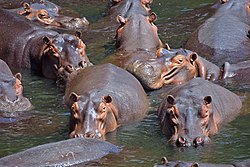Hippopotamidae
| Hippopotamidae Temporal range: 16–0 Ma Early Miocene-Holocene |
|
|---|---|
 |
|
| Common hippopotamus | |
 |
|
| Pygmy hippopotamus | |
| Scientific classification | |
| Kingdom: | Animalia |
| Phylum: | Chordata |
| Class: | Mammalia |
| Order: | Artiodactyla |
| Suborder: | Whippomorpha |
| Family: |
Hippopotamidae Gray, 1821 |
| Subtaxa | |
|
†Trilobophorous Geze, 1985 Hippopotaminae Gray, 1821 †Kenyapotaminae Pickford, 1983 |
|
†Trilobophorous Geze, 1985
Hippopotaminae Gray, 1821
†Kenyapotaminae Pickford, 1983
Hippopotamuses are stout, naked-skinned, and amphibious artiodactyl members (and the only living members) of the family Hippopotamidae possessing three-chambered stomachs and walking on four toes on each foot. While they resemble pigs physiologically and are pseudoruminants like camels, their closest living relatives are actually the cetaceans (whales and dolphins).
There are two living species of hippopotamus in two genera; the pygmy hippo, Choeropsis liberiensis of the forests of west Africa, and the common hippo, Hippopotamus amphibius.
Hippopotamuses are large mammals, with short, stumpy legs, and barrel-shaped bodies. They have large heads, with broad mouths, and nostrils placed at the top of their snouts. Like pigs, they have four toes, but unlike pigs, all of the toes are used in walking. Hippopotamids are unguligrade, although, unlike most other such animals, they have no hooves, instead using a pad of tough connective tissue on each foot. Their stomachs have three chambers, but they are not true ruminants.
The living species are smooth-skinned and lack both sebaceous glands and sweat glands. The outer epidermis is relatively thin, so hippos dehydrate rapidly in dry environments.
Both the incisors and canines are large and tusk-like, although the canine tusks are by far the larger. The tusks grow throughout life. The postcanine teeth are large and complex, suited for chewing the plant matter that comprises their diets. The number of incisors varies even within the same species, but the general dental formula is:
...
Wikipedia
